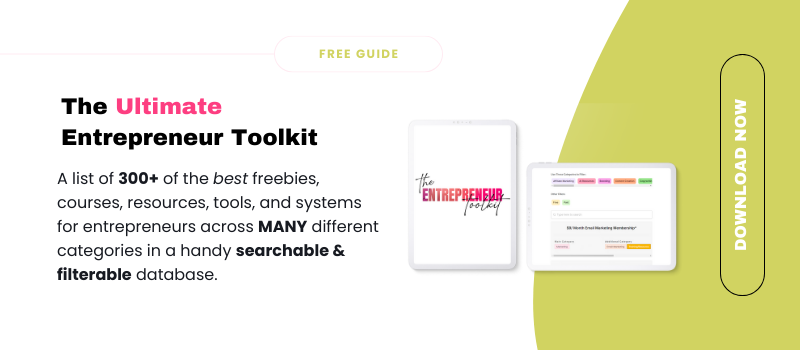Struggling to get the results you want from your emails?
Discover 15 simple yet powerful ways to elevate your email marketing and start seeing real engagement!
Grab your freebie!
Blog Categories
Helping small business owners, virtual assistants, and creative entrepreneurs grow their business.
Hi, I'm Tara! I'm a multi-passionate business and marketing coach.
learn more + get a copy:
Last Updated on October 13, 2025 by Tara Reid
I’ve hosted several virtual summits at this point, including the Freelance Revenue Boost virtual summit and the annual Introvertpreneur virtual summit. One thing is for sure, creating and hosting a virtual summit is a huge project but so much fun! If you are thinking about hosting a virtual summit of your own, then keep reading; this blog post is just for you.
Disclaimer: I earn from qualifying purchases. Some of the links on my website are affiliate links, which means, at no additional cost to you, I will earn a small commission if you click through and make a purchase.
- What is a Virtual Summit?
- The Benefits of Hosting a Virtual Summit
- The Benefits of Virtual Summits vs In-Person Summits
- Steps to Creating and Hosting a Virtual Summit
- Tips for Managing Virtual Summit Speakers
- Virtual Summit Hosting Platforms
- Tips to Boost Engagement as a Summit Host
- The Tech for Your Virtual Summit
- Final Thoughts
What is a Virtual Summit?
A virtual summit is an online event similar to a conference. Typically, summits will have presenters each day on topics that are relevant to the summit audience and niche. Some virtual summits will have live sessions or be entirely pre-recorded. There is also the option of running your virtual summit as an audio summit, too.
Virtual summits have increased a lot in popularity in recent years, and I’m happy to say that I don’t see them going away anytime soon. But, because they are more popular and there are more summits happening every single month… it’s more important than ever to make your event stand out when you decide to host a virtual summit.
You are going to have more competition now, and summit attendees might be getting a little overwhelmed with all of the event options.
That means it’s up to you to host a virtual summit that is specific, addresses their needs, and provides a streamlined attendee experience!
Is there a Difference Between a Virtual Summit and an Online Conference?
One of the big questions you might be thinking when deciding to host a virtual summit is about other terms. Is there a difference between a virtual summit and an online conference (sometimes also called a virtual conference)?
In my opinion, most people use the terms interchangeably. If your summit audience is B2C (business to customer), they might not have heard the term “summit” before. And in that case, you might want to call your event an online conference instead.
The Benefits of Hosting a Virtual Summit
Before we jump into how to create a virtual summit, it’s important to consider all of the wonderful benefits of hosting a virtual summit.
1) BUILDING YOUR NETWORK
Hosting an event like an online virtual summit allows you to make new connections and build your network. You’ll be collaborating with your guest speakers, which means great future connections for future collaborations. I’ve had so many of my wonderful speakers on my podcast, invited them to other collab opportunities, and became a fan of their work.
This is something I didn’t even think about or expect when I hosted my first summit. But it’s such a powerful way to grow your network of amazing people.

2) GROWING YOUR AUDIENCE & EMAIL LIST
One of the biggest benefits of hosting your own virtual summit is of course the list building aspect. When you’re a speaker at another summit, you’ll receive new leads from people opting into your freebie. But, when you are hosting a summit, every attendee becomes a new lead on YOUR email list.
The very first summit I hosted was the Introvertpreneur Virtual Summit in April 2021, and it resulted in growing my list with 1,500 new people. That’s some powerful and quick lead generation!
You would have to pay thousands of dollars in ad spend to get that many leads that quickly!
3) THE IMPACT OF A VIRTUAL SUMMIT
As the host and face of a successful virtual summit, it builds authority and a level of trust with your audience. We always hear about the ‘know, like, and trust’ factor. A successful virtual summit of your own is the perfect way to build this authority.
4) REVENUE FROM A VIRTUAL SUMMIT
Of course, we can’t forget about the revenue from hosting a virtual summit. Normally, you’ll make money from people purchasing an all access pass or VIP ticket to your event. Typically virtual summits will have a free ticket level and then an all access pass level (or two!) that include extras, such as lifetime replay access, a bundle of normally paid products, special workshops, etc.
You can also generate revenue by having sponsors for your event.
I’ve personally only done sponsorships a couple of times out of my 8 events because I didn’t want sponsors to distract from my amazing speakers.
The Benefits of Virtual Summits vs In-Person Summits
What are some of the differences and benefits of virtual summits vs in-person events? Well, the big one is that they are more accessible to more people. Your attendees won’t have to worry about travel plans, expensive flights, or who will be able to look after their kids while they attend. Attending virtual summits is a huge benefit because everyone can show up as they are!
Most of the time, I’m wearing pajama pants and slippers, FYI.
As event organizers or event hosts, it also costs a lot less to hold a virtual event than it would to organize an in-person event. With in-person you have to book a location, pay deposits, hire help, and there are a lot more pieces to it. Virtual summits are definitely more cost-effective, and there’s very little risk to you as the summit host.
Steps to Creating and Hosting a Virtual Summit
If those benefits of hosting a virtual summit are making you think, ‘heck yes! I want to host a virtual summit myself!’ here are the key things you’ll need to think about:
1) DETERMINE YOUR SUMMIT TOPIC AND TARGET AUDIENCE
As virtual events have become more popular, I feel like it’s more important than ever to niche down your special event topic and target audience. If your summit is focused on B2B (business to business) audiences, what stage are they at in business? What are they struggling with or want to learn more about?
Who exactly is the intended audience for this online summit?
Having a more specific area of focus will help improve your attendance, and your new leads will be much more suited for your business.
2) DECIDE IF YOU’LL NEED TO HIRE HELP
Your first virtual summit takes a lot of planning and creating things from scratch. It might be a huge benefit to hire help for your event. This could include help around certain areas, like the tech or page design, or you could hire someone to manage the entire event.
My virtual assistant, for example, is essential for managing any of my virtual summits! While I do all of the marketing, copy, tech, and design, she helps with all of the admin and scheduling.
3) ORGANIZATION IS KEY
A virtual summit has a lot of moving pieces – planning, creation, speaker management, affiliate management, and ensuring that nothing falls through the cracks. To make a virtual summit a truly seamless experience for attendees and guest speakers, you’ll want to keep yourself on track with an event agenda.
Ready to host a virtual summit? Start by planning out your virtual summit format with some key questions:
- Will you be offering this as a paid or free virtual summit?
- If it’s a free event, will there be an all access pass available to summit attendees?
- Are there going to be any live or interactive events for attendees?
- Are the guest expert presentations going to be pre recorded sessions or done live?
- What is your goal for attendee registration?
- How will you increase attendee engagement during the online event?
My favorite resource is Krista Miller’s Summit in a Box. I purchased this program about 6 months before I kicked off my very first virtual summit, and it truly covers everything. I can’t recommend it enough for anyone planning to host their own virtual summit. Your virtual summit planning will be so much easier!
4) FINDING AND PITCHING SPEAKERS
Selecting the right guest speakers for your event can be a challenge. Pitching can be a scary process, even if it is a collaboration opportunity like this. Have a set process to make it easier on yourself when you invite speakers to your virtual summit and start doing speaker outreach.
Are you going to have keynote speakers for the event? Lining up a few thought leaders or industry leaders as keynote speakers can definitely drive more registrations for your event. But, you will need to consider any speaker fees or costs.
On the other hand, if you open a call for speakers with an application form, you might end up with hundreds of applicants.
I’m speaking from experience here! My last summit had over 200 applicants, and it was so hard to decide who to invite to the event. You also want to make sure that you include a diverse and inclusive line-up of guest speakers and industry experts for your event.

5) THE SUMMIT SPECIFICS AND SUMMIT EXPERIENCE
Every virtual summit will look different. Will you have live panels? Will presentations be delivered live or pre-recorded? Will there be a community for attendees to connect?
You’ll have to make a lot of key decisions when it comes to your virtual summit and what you want the event to look like.
6) VIRTUAL SUMMIT PROMOTION
Once you have everything scheduled and planned out, you’ll still need to think about how you will be promoting the virtual summit. You will have speakers and affiliates ready to promote. What will they need to be able to promote easily? The easier you make it for your speakers, the more likely they are to promote and share the event!
Will you be running any paid ads?
How will you encourage free attendees to upgrade to an all access pass? Will there be fast action pricing after they sign up? Will there also be early bird pricing for the all access pass?
Will you be doing any kind of affiliate or speaker leaderboard? Doing this can sometimes prompt more engagement because who doesn’t love a friendly little competition with prices?
Tips for Managing Virtual Summit Speakers
Your speakers are the stars of your virtual summit. Without speakers, you don’t have an event. It’s just as important to make sure you create a seamless experience for your speakers as it is for your attendees.
1) Do you have keynote speakers?
If you have keynote speakers or different levels of speakers for your event, it’s important to keep track of everything in one central place. I personally use Airtable for all my speaker management, outreach, communication, and management for my virtual events.
2) How can you keep speakers informed?
Communication is key! What do speakers need to know before, during, and post event? You can never over-communicate or remind too much. I promise you aren’t bothering your speakers. You’re making it super easy on them to share, promote, and stay on track.
3) How can you make this a great experience for your speakers?
Should you create a speaker-only Facebook Group or Slack channel to encourage connections? And as a speaker in dozens of other virtual summits, here are a few things to think about:
- When you email with a presentation reminder email or an accepted email, make sure to auto-include what the speaker submitted. I do a lot of events and sometimes can’t keep track of what topic I submitted. It’s my fault, but if you can make it easier for people, they will appreciate it!
- One event had live panels where you signed up on a Google Sheet, but there was no reminder about signing up for them. It was just casually mentioned in one email that contained a lot of other stuff about the event.
- If speakers are also affiliates and your virtual summit has an all access pass, make it easy for them to promote and share the event! Tell them where to get their affiliate link — or better yet, have it automatically inserted into your emails (yay for automations!)
Virtual Summit Hosting Platforms
So, what virtual summit platform should you use to host your summit? There are a lot of options out there now! I’ve personally used ThriveCart as my virtual summit platform. I just create 2 separate ‘products’ in ThriveCart Learn – one for free ticket holders and one for all access pass holders. While ThriveCart Learn isn’t designed specifically as a virtual event hosting platform, it works perfectly for me!
I’ve also attended events that worked well using HeySummit, Simplero, or Teachery as the virtual summit platforms.
What virtual summit hosting platform is right for you? It really depends on what features you’ll need for your specific event structure. There’s no one size fits all answer!
Take a look at the cost and features included for each virtual summit platform to figure out if it will work for your virtual event or not.

Tips to Boost Engagement as a Summit Host
Want to learn more ways to increase engagement during your virtual event? We all know that attendee engagement is a good indicator of a successful summit, but let’s be honest: most summits see a drop-off during the middle of the event. That’s completely normal!
But there are some ways we can encourage our event attendees and create a better virtual summit experience for them.
1) Email Marketing Reminders for Attendees
Your event email marketing reminders aren’t just to sell more of your all access pass upgrade. They should create a premium attendee experience and make it super easy for attendees to attend, engage, and interact with the event.
The more emails, the better!
2) Engage Attendees with Networking Rooms
Live events with networking features are great to get attendees excited about showing up!
3) Add More Live Experiences
Want even more attendee engagement? Host a virtual summit with more live experiences, like a kick-off call for the event, a special giveaway, hot seats, live panels, or other fun virtual events. The Females on Fire Virtual Summit even hosts a virtual dance party every summit and the attendees LOVE it!
4) Networking Features for Summit Speakers and Attendees
Have somewhere that allows attendees and summit speakers to engage and interact. This could be a pop-up Facebook Group for the event or a private community. And make sure to include the link to join in every single attendee email you send out!
The Tech for Your Virtual Summit
We talked a bit earlier about platforms, but what about other tech you might need for your summit?
Here are a few tech pieces that you might need, depending on your event structure.
1) Create an Intro Video for Presentations
You can create a fun intro video to add to each speaker’s presentation to help with branding your summit. A few tools that you could use to do this are PlaceIt or Canva.
While this is totally optional, it might be a good idea for smaller events or if you have a team member who can add the intro to all speaker video presentations.
2) Create Transcripts for Presentations
I personally started including transcriptions for each presentation for all attendees, free or paid, to offer more accessible options for interacting with the content.
I love Otter for all transcriptions, but you can also use Rev.com if you want better results that require less editing and fixing up.
3) Live Event Hosting Options
Most summit hosts use Zoom for live events, but you’ll want to consider if you need to upgrade to Zoom Webinars or not. With Zoom webinars, you have more control over the functionality of the Zoom experience.
You might also want to consider if you’ll want to have a live streaming option to stream the Zoom live events into the attendee community.
4) Video Hosting Platform
Unless your hosting platform includes video uploads, you’ll need a separate place to upload & host your summit videos and replays. I personally use Vimeo, but you could also use:
- YouTube: You’ll need to make your videos as ‘unlisted’ so they aren’t publicly accessible without the direct link. However, this will show ads, and YouTube recommended videos on the player.
- Wistia
5) Other Tools to Consider
A few other tools that might be helpful to consider for your virtual summit are:
- VideoAsk: I’ve used VideoAsk previously for a summit to put together pre-recorded panels. Each panelist recorded their answer to each question, and then we edited them all together. It was a lot of editing work, but it might be a good option in place of live events.
- Descript: An easy-to-use video editing tool that allows you to edit videos by editing the transcript.
- HelloAudio: I love HelloAudio and use it for every private podcast audio feed for each of my virtual summits and events. I typically include this in the all access pass.
Final Thoughts
Your first virtual summit will be the hardest, and it’s important to keep that in mind. Once you have one online event under your belt, it will be much easier to run your next one! You can re-use your processes, systems, automations, and even re-use some of your marketing materials that worked well.
Every virtual summit is a learning experience! And your next virtual summit will be so much easier, I promise!
If you’re looking for more virtual summit ideas and resources, make sure to check out these links below:
- Summit in a Box
- Virtual Summit Search
- PODCAST: Running and Hosting Online Events and Virtual Summits as an Introvert
- PODCAST: The Power of Virtual Summits and How to Find Speaking Opportunities
- PODCAST: 4 Big Mistakes I Made With My Last Virtual Event
Tara Reid is a multi-passionate business and marketing strategist for introverted entrepreneurs who want to grow without relying on hustle culture or social media. With 18+ years of online business experience, she helps course creators, service providers, and digital product sellers build sustainable businesses through evergreen marketing, blogging, SEO, Pinterest, and email.
As the founder of the Introvertpreneur Club, Tara’s mission is to show heart-centered entrepreneurs that you don’t have to be loud to be successful. You just need the right strategies that fit your personality.
When she’s not supporting clients or creating new resources, you can find her at home in Canada with her three rescue dogs, a cup of coffee in hand, dreaming up her next project.
The Introvertpreneur Podcast
listen in to the top rated business podcast that is designed for introverted entrepreneurs who want to grow + scale in a more sustainable and fun way!
Top rated podcast
This one's on me. Complimentary free stuff coming right up.
leaving so soon?
Look behind the curtain and see exactly what I do every week, month, and quarter, to market my business without social media (in under 5 hours per week)!
The Quiet Marketing Playbook
Take this free quiz and learn what your superpower is as an entrepreneur. You'll also get a curated list of my best resources and tips for using your superpower to your advantage!
What's your Introverted Superpower?
Best Free Resources:
dig into 'em now!
A business strategist and marketing coach who focuses on helping course creators, coaches, and service providers, build sustainable businesses without social media.
